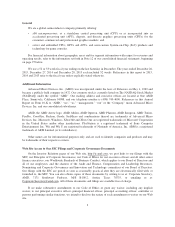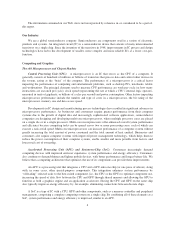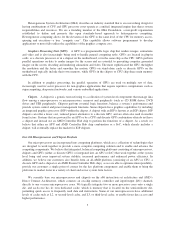AMD 2015 Annual Report Download - page 18
Download and view the complete annual report
Please find page 18 of the 2015 AMD annual report below. You can navigate through the pages in the report by either clicking on the pages listed below, or by using the keyword search tool below to find specific information within the annual report.Other competitors include a variety of companies providing or developing ARM-based designs at relatively
low cost and low power processors for the computing market including tablets and thin-client form factors, as
well as dense servers, set-top boxes and gaming consoles. ARM Holdings designs and licenses its ARM
architecture to third parties, including us, and offers supporting software and services. Our ability to compete
with companies who use ARM-based solutions depends on our ability to timely design and bring to market
energy-efficient, high-performing products at an attractive price point.
In the chipset market, our competitors include suppliers of IGP chipsets. PC manufacturers use IGP chipsets
because they typically cost less than traditional discrete GPUs while offering acceptable graphics performance
for most mainstream PC users. Intel also leverages its dominance in the microprocessor market to sell its IGP
chipsets. Intel manufactures and sells IGP chipsets bundled with their microprocessors and is our main
competitor in this market.
Competition in the Graphics Markets
In the graphics market, our competitors include suppliers of discrete graphics, embedded graphics
processors and IGP chipsets. Intel manufactures and sells embedded graphics processors and IGP chipsets, and is
a dominant competitor with respect to this portion of our business. Higher unit shipments of our APUs and
Intel’s integrated graphics may drive computer manufacturers to reduce the number of systems they build paired
with discrete graphics components, particularly for notebooks, because they may offer satisfactory graphics
performance for most mainstream PC users, at a lower cost. Intel could take actions that place our discrete GPUs
and IGP chipsets at a competitive disadvantage such as giving one or more of our competitors in the graphics
market, such as Nvidia Corporation, preferential access to its proprietary graphics interface or other useful
information.
Our principal competitor in the graphics market is Nvidia. AMD and Nvidia are the two principal players
offering discrete graphics solutions. Other competitors include a number of smaller companies, which may have
greater flexibility to address specific market needs, but less financial resources to do so, especially as we believe
that the growing complexity of graphics processors and the associated research and development costs represent
an increasingly higher barrier to entry in this market. In the semi-custom game console products, where graphics
performance is critical, we compete primarily against Nvidia, and also compete against Imagination Technology
Group.
Research and Development
We focus our research and development activities on improving product performance and enhancing
product design. Our main area of focus is on delivering the next generation of CPU and GPU IP, and designing
that IP into our SoCs for our next generation of products,with, in each case, improved system performance and
performance-per-watt characteristics. For example, we are focusing on improving the battery life of our
microprocessors and APU products for notebooks and the power efficiency of our microprocessors for servers.
We are also focusing on delivering a range of low-power integrated platforms to serve key markets, including
commercial clients, mobile computing and gaming and media computing. We believe that these platforms will
bring customers increased performance and energy efficiency. We also work with industry leaders on process
technology, software and other functional intellectual property and we work with others in the industry and
industry consortia to conduct early stage research and development.
Our research and development expenses for 2015, 2014 and 2013 were approximately $0.9 billion,
$1.1 billion and $1.2 billion, respectively. For more information, see “Part II, Item 7-Management’s Discussion
and Analysis of Financial Condition and Results of Operations,” below.
We conduct product and system research and development activities for our products in the United States
with additional design and development engineering teams located in China, Canada, India, Singapore, Taiwan
and Israel.
12
























